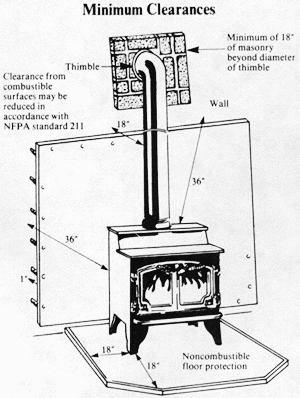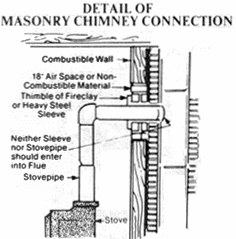Woodstove Safety
Protecting Your Home
With the ever-increasing cost of home heating, more and more energy conscious people are installing wood stoves. An undesirable result has been a corresponding increase in the number of wood stove and chimney fires. In fact, over one-half of the one-and two-family dwelling fires in rural and suburban areas are caused by wood fuel use.
Burning wood requires more work and attention than simply adjusting a thermostat. To reduce the chances of having a fire in your home, follow the recommendations in the Woodstove Safety pamphlet below on proper selection, installation, maintenance and operation of a wood stove.
With the ever-increasing cost of home heating, more and more energy conscious people are installing wood stoves. An undesirable result has been a corresponding increase in the number of wood stove and chimney fires. In fact, over one-half of the one-and two-family dwelling fires in rural and suburban areas are caused by wood fuel use.
Burning wood requires more work and attention than simply adjusting a thermostat. To reduce the chances of having a fire in your home, follow the recommendations in the Woodstove Safety pamphlet below on proper selection, installation, maintenance and operation of a wood stove.
| Woodstove Safety Pamphlet 1)Selection and Installation 2)Know Your Wood Stove 3)After Installation 4)Additional Information |
Selection and Installation
When choosing a wood stove, select one which is listed by a nationally approved testing laboratory. The stove should: be made of a safe durable material with a long life-span; sized for the the area to be heated; have air tight door gaskets, sealed joints, a secure latch, and a draft control to regulate the fire.
If a second hand stove is purchased, it should not have any broken parts or cracks which would make it unsafe to use.
Proper installation of a wood stove is the foundation for safe operation. READ AND FOLLOW the manufacturer's installation instructions. Also consult the local code enforcement official and fire department for their recommendations, code requirements and necessary permits.
The following diagrams illustrate the installation recommendations of the State Fire Prevention and Building Code.

Once the wood stove has been installed, become familiar with its parts and their operation. Proper maintenance can reduce the possibility of fire.
- The stovepipe is the vital link between the stove and the chimney. When setting it up, use 24 gauge or thicker pipe. The pipe should be as short and as straight as possible. Secure each joint with at least three screws. The horizontal part should rise one-quarter inch per foot.
The pipe should be installed so that an upper pipe section fits inside the lower section. This allows the creosote to flow inside the pipe. the stovepipe should extend into the thimble so the end of the stovepipe is flush with the inner end of the thimble.
A damper is used to control draft and loss of volatile gas. If there is no damper in the stove, one should be installed in the stovepipe.

- The chimney serves two functions: it creates a draft, and it evacuates the gases of combustion. It should extend at least three feet above the highest point where it passes through the roof and two feet above any portion of the building within 10 horizontal feet of the chimney.
If connecting to an existing chimney, it should be inspected before using. A complete inspection includes a check of the inner liner for cracks and deterioration, unused openings properly sealed and a check that the chimney is clean and unblocked.
When correctly installed in accordance with the manufacturer's specifications and properly maintained, prefabricated chimneys are a safe and relatively inexpensive way to remove smoke and gases from the stovepipe. This is done through an existing wall or roof to the outdoors. All prefabricated chimneys for use in residences must be approved and listed in accordance with UL 103 or meet the requirements of the New York State Uniform Fire Prevention and Building Code.
- Creosote is a deposit formed in the chimney and stovepipe as condensed wood smoke. The amount that forms varies according to the density of the smoke, the surface temperature of the chimney and the type and dryness of the wood being burned.
Creosote is formed when wood smolders and does not burn completely. To help reduce creosote buildup, burn a hot roaring fire for 15 to 30 minutes every day. Also, be sure not to overload the firebox so sufficient oxygen is available to keep the fire burning.
- Fuel. When choosing fuel for a wood stove, become familiar with the various types of wood:
Seasoned wood is cut down at least six months prior to burning and is preferred over green wood because it has less moisture content.
Green wood burns but much of the stove's efficiency is sacrificed.
Softwood does not produce more creosote. It burns faster and is usually preferred for kindling.
Hardwood generally burns longer than softwood and generates more coals.
The following precautions should be taken to ensure the greatest amount of safety:
- Check the stovepipe and chimney for buildup of creosote. Clean these areas when accumulation exceeds one-quarter inch.
- Never use a flammable liquid to start a fire and never work with a flammable liquid in the same room when a wood stove is in operation.
- Use a metal container with a tight-fitting lid for ash disposal. Dispose of ashes only after they have cooled.
- Keep children away from the stove. Even a quick touch to the stove's surface can result in severe burns.
- Install a smoke detector for early warning in case a fire starts.
- Develop and practice an escape plan from all rooms in the house.
Fire safety brochures available from the Department of State include:
- Arrest Arson
- Barbecue Safety
- Christmas Tree Safety
- EDITH - Exit Drills in the Home
- Fireplace Safety
- High-Rise Fire Safety (also available in Spanish)
- Home Fire Extinguishers (also available in Spanish)
- Hotel/Motel Safety
- Smoke Detectors
- Wood Stove Safety
Contact:
Office of Fire Prevention & Control
5th Floor, Suite 500
One Commerce Plaza
99 Washington Avenue
Albany, NY 12231
Tel: 518-474-6746
Fax: 518-474-3240.



Comments